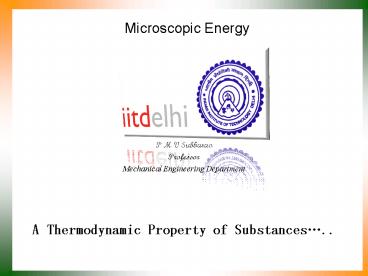Microscopic Energy - PowerPoint PPT Presentation
1 / 25
Title:
Microscopic Energy
Description:
Microscopic Energy P M V Subbarao Professor Mechanical Engineering Department A Thermodynamic Property of Substances .. Hydro Electric Plant : The Work Done by A ... – PowerPoint PPT presentation
Number of Views:225
Avg rating:3.0/5.0
Title: Microscopic Energy
1
Microscopic Energy
- P M V Subbarao
- Professor
- Mechanical Engineering Department
A Thermodynamic Property of Substances..
2
Hydro Electric Plant The Work Done by A Falling
Water Ligament
3
Microscopic Energy
- This energy is defined as the energy associated
with the random, disordered motion of molecules
and due to intermolecular forces. - It is separated in scale from the macroscopic
ordered energy associated with moving or
stationary objects - It refers to the invisible form of energy at
atomic and molecular scales. - Popularly known as Internal Energy, U.
4
Internal (Microscopic) Energy Ideal Gas
- Internal energy involves energy at the
microscopic scale. - Potential and Kinetic energies of individual
molecules/atoms. - But the potential energy is associated with
intermolecular forces which are presumed to be
zero in an ideal gas. - Therefore the internal energy of an ideal gas is
entirely kinetic energy.
5
Internal (Microscopic) Energy Monatomic Ideal
Gas
- For an ideal monatomic gas, this is just the
translational kinetic energy of the linear motion
of the "hard sphere" type atoms.
For a monatomic ideal gas this change in internal
energy is given by
6
Internal (Microscopic) Energy Diatomic Ideal
Gas
- For polyatomic gases there is rotational and
vibrational kinetic energy as well.
7
Internal (Microscopic) Energy Polyatomic Ideal
Gas
8
Internal (Microscopic) Energy Other Substances
- Then in real gases, liquids and solids there is
potential energy associated with the
intermolecular attractive forces.
9
Increase of Internal Energy
Supply enough heat to each of these systems till
the there is 1?C increase in temperature.
10
Internal Energy and Temperature
11
Internal Energy of an Ideal Gas
- Internal energy in general includes both kinetic
energy and potential energy associated with the
molecular motion. - But the potential energy is associated with
intermolecular forces which are presumed to be
zero in an ideal gas. - Therefore the internal energy of an ideal gas is
entirely kinetic energy. - For a monoatomic ideal gas this change in
internal energy is given by
- If rotation and vibrational kinetic energies are
involved (polyatomic molecules) then
f Number of degrees of freedom of a molecule
12
Means to Measure Energy
- Macroscopic Energy Easy to measure.
- Microscopic Energy Needs a detailed experiment.
- Identify methods to measure economically.
13
Measurement of Change in Internal Energy
- First law for A control mass
Constant Volume Heating
1Q2 U2 U1
- Consider a homogeneous phase of a substance with
constant composition. - Define Specific Heat The amount of heat required
per unit mass/mole to raise the temperature by
one degree. - No change in other forms of energy, except
internal energy.
14
Constant Volume Specific Heat
- The molar specific heat at constant volume is
defined by
- For a monatomic ideal gas,
15
CV Specific Heats of Ideal Gases
Experimental results
16
(No Transcript)
17
Polytropic Process of A Control Mass
- Polytropic process of a control mass
18
Measurement of Changes during Constant Pressure
Process
- Constant pressure heating of a control mass
Constant Pressure Heating
19
Changes during Constant Pressure Process
- Infinitesimal constant pressure heating process
by a control mass
The quantity pV is also having a behaviour of
property ! This is called flow energy, flow work
or internal work. However, the significance of
this property is not felt in a Control Mass.
Constant Pressure Heating
Another way of representing this effect is to
combine U and PV. Let this be H.
20
The issue of Increasing unit Temperature of A
Pure Substance
21
Flow Work or Flow Energy
- Unlike control mass, control volumes involve mass
flow across their boundaries. - The substance inside a control volume will be at
some pressure, temperature.. - The fluid entering the control volume is pushing
itself against the pressure of the control
volume. - Some work transfer is involved in pushing this
mass into the control volume. - This is an internal work.
- This is called flow work or flow energy.
22
Visualization of Flow Work
- F pA will be a driving force responsible for the
pushing of the fluid into the CV. - This force will perform a work transfer of F.L to
push the fluid. - Therefore, the flow work F L p A L p
V - This can exists even when there is a fluid pushed
out of the CV.
23
Flow work
- It is interesting to note that unlike other work
quantities, the flow work is expressed in terms
of state variables. - This is also a state variable, point function and
hence a thermodynamic property. - This is also called flow energy, convected energy
or transport energy. - The total energy of non flowing fluid E m(u
½V2 gz) - The total energy of flowing fluid Q m(u pv
½V2 gz). - This total energy is also called as Methalpy.
- The term u pv is called as specific Enthalpy, h.
24
Energy transport by Moving fluid
- Amount of energy transport by a moving fluid of
mass m - Q m? m ( h ½V2 gz )
- Rate of Energy Transport
25
Internal Energy Enthalpy of Wet Mixtures
- x is the dryness fraction.
- U (1-x) Uf x Ug
- Specific Internal energy Internal energy per
unit mass u - u (1-x) uf x ug
- Specific enthalpy
- h (1-x) hf x hg
T
ufg
uf
u
ug































